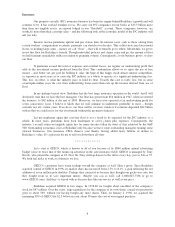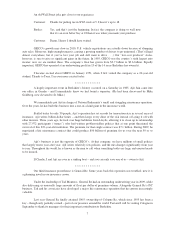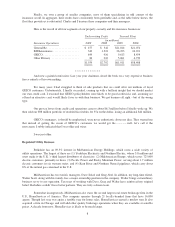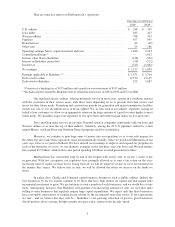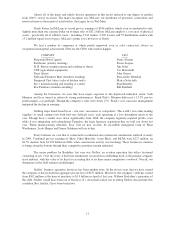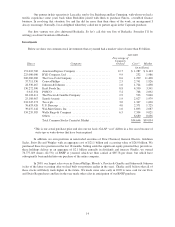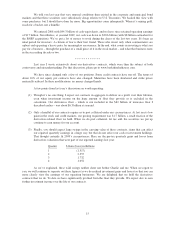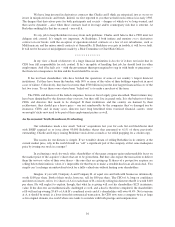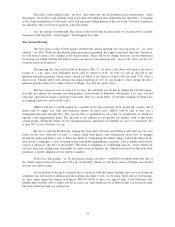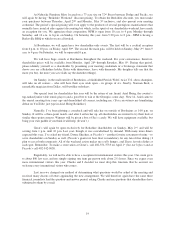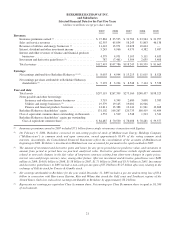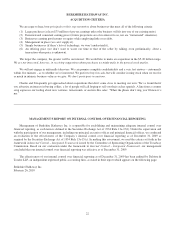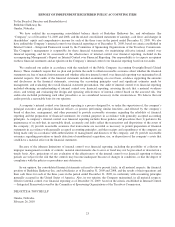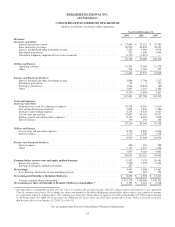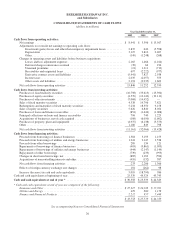Berkshire Hathaway 2009 Annual Report Download - page 18
Download and view the complete annual report
Please find page 18 of the 2009 Berkshire Hathaway annual report below. You can navigate through the pages in the report by either clicking on the pages listed below, or by using the keyword search tool below to find specific information within the annual report.We have long invested in derivatives contracts that Charlie and I think are mispriced, just as we try to
invest in mispriced stocks and bonds. Indeed, we first reported to you that we held such contracts in early 1998.
The dangers that derivatives pose for both participants and society – dangers of which we’ve long warned, and
that can be dynamite – arise when these contracts lead to leverage and/or counterparty risk that is extreme. At
Berkshire nothing like that has occurred – nor will it.
It’s my job to keep Berkshire far away from such problems. Charlie and I believe that a CEO must not
delegate risk control. It’s simply too important. At Berkshire, I both initiate and monitor every derivatives
contract on our books, with the exception of operations-related contracts at a few of our subsidiaries, such as
MidAmerican, and the minor runoff contracts at General Re. If Berkshire ever gets in trouble, it will be my fault.
It will not be because of misjudgments made by a Risk Committee or Chief Risk Officer.
************
In my view a board of directors of a huge financial institution is derelict if it does not insist that its
CEO bear full responsibility for risk control. If he’s incapable of handling that job, he should look for other
employment. And if he fails at it – with the government thereupon required to step in with funds or guarantees –
the financial consequences for him and his board should be severe.
It has not been shareholders who have botched the operations of some of our country’s largest financial
institutions. Yet they have borne the burden, with 90% or more of the value of their holdings wiped out in most
cases of failure. Collectively, they have lost more than $500 billion in just the four largest financial fiascos of the
last two years. To say these owners have been “bailed-out” is to make a mockery of the term.
The CEOs and directors of the failed companies, however, have largely gone unscathed. Their fortunes may
have been diminished by the disasters they oversaw, but they still live in grand style. It is the behavior of these
CEOs and directors that needs to be changed: If their institutions and the country are harmed by their
recklessness, they should pay a heavy price – one not reimbursable by the companies they’ve damaged nor by
insurance. CEOs and, in many cases, directors have long benefitted from oversized financial carrots; some
meaningful sticks now need to be part of their employment picture as well.
An Inconvenient Truth (Boardroom Overheating)
Our subsidiaries made a few small “bolt-on” acquisitions last year for cash, but our blockbuster deal
with BNSF required us to issue about 95,000 Berkshire shares that amounted to 6.1% of those previously
outstanding. Charlie and I enjoy issuing Berkshire stock about as much as we relish prepping for a colonoscopy.
The reason for our distaste is simple. If we wouldn’t dream of selling Berkshire in its entirety at the
current market price, why in the world should we “sell” a significant part of the company at that same inadequate
price by issuing our stock in a merger?
In evaluating a stock-for-stock offer, shareholders of the target company quite understandably focus on
the market price of the acquirer’s shares that are to be given them. But they also expect the transaction to deliver
them the intrinsic value of their own shares – the ones they are giving up. If shares of a prospective acquirer are
selling below their intrinsic value, it’s impossible for that buyer to make a sensible deal in an all-stock deal. You
simply can’t exchange an undervalued stock for a fully-valued one without hurting your shareholders.
Imagine, if you will, Company A and Company B, of equal size and both with businesses intrinsically
worth $100 per share. Both of their stocks, however, sell for $80 per share. The CEO of A, long on confidence
and short on smarts, offers 1
1
⁄
4
shares of A for each share of B, correctly telling his directors that B is worth $100
per share. He will neglect to explain, though, that what he is giving will cost his shareholders $125 in intrinsic
value. If the directors are mathematically challenged as well, and a deal is therefore completed, the shareholders
of B will end up owning 55.6% of A & B’s combined assets and A’s shareholders will own 44.4%. Not everyone
at A, it should be noted, is a loser from this nonsensical transaction. Its CEO now runs a company twice as large
as his original domain, in a world where size tends to correlate with both prestige and compensation.
16


